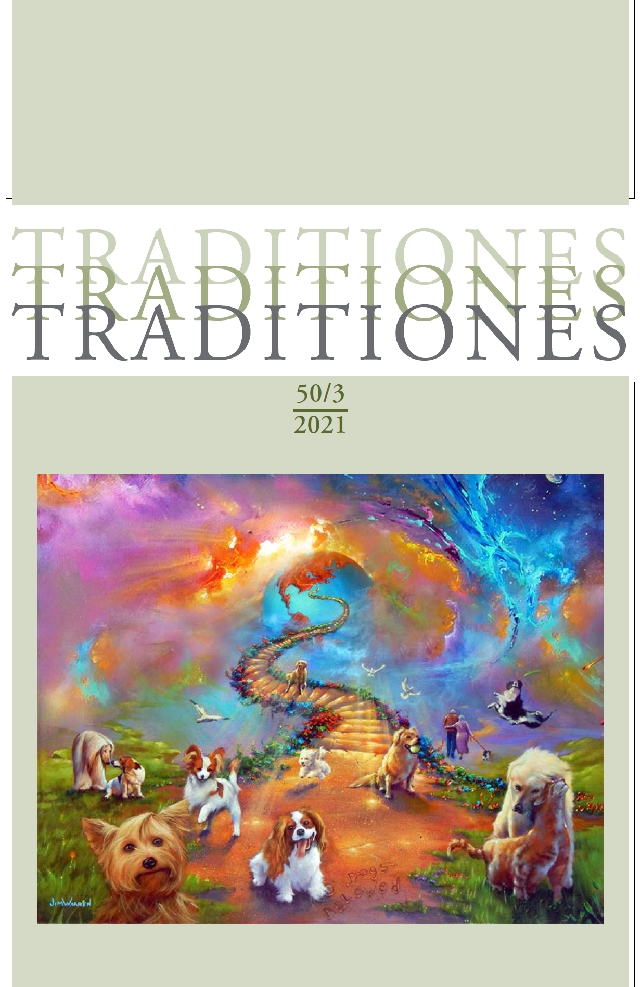Zaprisežene device v Balkanskem visokogorju
DOI:
https://doi.org/10.3986/Traditio2021500306Ključne besede:
čast, družbena anomalija, zaprisežene device, tradicionalni rituali, Zahodni BalkanPovzetek
Včasih široko razširjena prisega nedolžnosti v Dinarskem gorovju na Balkanskem polotoku je bila družbeni in kulturni ritual, dokumentiran med vsemi skupinami na tem območju. Po tem ritualu naj bi hči, če v družinskem gospodarstvu ni bilo sposobnega odraslega moškega, prevzela njegovo družbeno vlogo, tako da je 'postala' moški. Po standardni razlagi je funkcija te prakse omogočiti nadaljevanje gospodarskih, socialnih in verskih dejavnosti gospodinjstva. Avtorja menita, da ta razlaga ni ustrezna. Po njunih ugotovitvah pa je glavni razlog za prisego nedolžnosti reševanje družinske časti, saj je odsotnost posebne vrste moškega (sposobnega in častnega) v teh skupnostih sprejeta kot sramota.
Prenosi
Literatura
Barjaktarović, Mirko. 1948. Prilog proučavanju tobelija (zavetovanih devojaka). Zbornik Filozofskog fakulteta I: 343–352.
Barjaktarović, Mirko. 1966. Problem tobelija (virdžina) na Balkanskom poluostrvu. Glasnik Etnografskog muzeja u Beogradu 28–29: 273–286.
Bošković, Aleksandar. 1996. Constructing Gender in Contemporary Anthropology. PhD Thesis. University of St Andrews.
Dekker, Rudo M., and Lotte C. van de Pol. 1989. The Tradition of Female Transvestism in Early Modern Europe. Houndmills: Macmillan Press Ltd. DOI: https://doi.org/10.1007/978-1-349-19752-1.
Denich, Bette S. 1974. Sex and Power in the Balkans. In Woman, Culture and Society, eds. Michelle Z. Rosaldo and Louise Lamphere, 243–262. Stanford: Stanford University Press.
Dickemann, Mildred. 1997. The Balkan Sworn-Virgin: A Cross-Gendered Female Role. In Islamic Homosexualities: Culture, History and Literature, eds. Stephen O. Murray and Will Roscoe, 197–203. New York: New York University Press.
Djajic Horváth, Aleksandra. 2003. A Tangle of Multiple Transgressions: The Western Gaze and the Tobelija (Balkan Sworn-Virgin-Cross-Dressers) in the 19th and 20th Centuries. Anthropology Matters Journal 2. https://www.anthropologymatters.com/index.php/anth_matters/article/view/119/234.
Douglas, Mary. 1984 (1966). Purity and Danger: An Analysis of the Concepts of Pollution and Taboo. London, New York: Routledge.
Durham, Mary E. 1910. High Albania and its Customs in 1908. Journal of the Royal Anthropological Institute 40: 453–72.
Đorđević, Tihomir. 1984 (1930). Naš narodni život 6, 276–278. Beograd: Prosveta. [Originally published in Sveslovenski zbornik (Zagreb).]
Gavrilović, Ljiljana. 1983. Tobelije: Zavet kao osnov sticanja pravne i poslovne sposobnosti. Glasnik Etnografskog muzeja 47: 67–80.
Grémaux, René. 1989. Mannish Women of the Balkan Mountains: Preliminary Notes on the ‘Sworn Virgins’ in Male Disguise, with Special Reference to Their Sexuality and Gender-Identity. In From Sappho to De Sade: Moments in the History of Sexuality, ed. Jan N. Bremmer, 143–172. London: Routledge.
Grémaux, René. 1992. Fransciscan Friars and the Sworn Virgins of the North Albanian Tribes. Religion State & Society 20 (3-4): 361–374. DOI: https://doi.org/10.1080/09637499208431565.
Grémaux, René. 1994. Woman Becomes Man in the Balkans. In Third Sex, Third Gender — Beyond Sexual Dimorphism in Culture and History, ed. Gilbert Herdt, 241–281. New York: Zone Books.
Gušić, Marijana. 1958. Ostajnica-tombelija-virdžina kao društvena pojava. In Treći kongres folklorista Jugoslavije držan od 1-9.IX.1956.g. u Crnoj Gori, ed. M. S. Lalević, 55–64. Cetinje: Savez folklorista FNRJ.
Gušić, Marijana. 1976. Pravni položaj ostajnice-virđineše u stočarskom društvu regije Dinarida.’ In Odredbe pozitivnog zakonodavstva i običajnog prava o sezonskim kretanjima stočara u Jugoistočnoj Evropi kroz vekove: Zbornik radova sa međunarodnog naučnog skupa održanog 6. i 7. novembra 1975. u Beogradu, ed. Vasa Čubrilović, 269–295. Beogad: Srpska akademija nauka i umetnosti.
Heneberg-Gušić, Marijana. 1930. Etnografski prikaz Pive i Drobnjaka. Etnološka biblioteka 10: 3–17.
Jovanović, Miroslav, and Slobodan Naumović, eds. 2004. Gender Relations in South Eastern Europe: Historical Perspectives on Womanhood and Manhood in 19th and 20th Century. Münster: Lit Verlag.
Kaser, Karl. 1994. Die Mannfrau in den patriarchalen Geselschaften des Balkans und der Mythos vom Matriarchat. L’Homme 5 (1): 59–77.
Mascia-Lees, Frances E., and Nancy Johnson Black. 2017. Gender and Anthropology. 2nd Ed. Long Grove: Waveland Press.
Medaković, Milorad. 2001 (1860). Život i običaji Crnogoraca. Beograd: Nikola Pašić.
Moore, Henrietta. L. 1988. Feminism and Anthropology. Minneapolis: University of Minnesota Press.
Simić, Andrei. 1967. The Blood Feud in Montenegro. Essays in Balkan Ethnology (Berkeley) 1: 83–94.
Šarčević, Predrag. 1999. Tobelija: Female-to-Male Cross-Gender Role in the 19th and 20th Century Balkans. In the Archives and the Field: Dialogue on Historical Anthropology of the Balkans, eds. Miroslav Jovanović, Karl Kaser and Slobodan Naumović, 135–146. Belgrade, Graz: Udruženje za društvenu istoriju, Institut für Geschichte der Universität Graz, Abteilung Südosteuropäische Geschichte.
Šarčević, Predrag. 2004. Sex and Gender Identity of ‘Sworn Virgins’ in the Balkans. In Gender Relations in South Eastern Europe: Historical Perspectives on Womanhood and Manhood in 19th and 20th Century, eds. Miroslav Jovanović and Slobodan Naumović, 125–141. Münster: Lit Verlag.
Tarifa, Fatos. 2007. Balkan Societies of “Social Men”: Transcending Gender Boundaries. Societies Without Borders 2 (1): 75–92. DOI: https://doi.org/10.1163/187188607X163275.
Tarifa, Fatos. 2008. Of Time, Honor, and Memory: Oral Law in Albania. Oral Tradition 23 (1): 3–14.
Vince Pallua, Jelka. 2014. Zagonetka virdžine: Etnološka i kulturnoantropološka studija. Zagreb: Institut društvenih nauka Ivo Pilar.
Von Hahn, Johann Georg. 1867. Reise durch die Gebiete des Drin und Wardar. In Auftrage der k. Akademie der Wissenschaften unternommen im Jahre 1863. Wien: Aus der K.K. Hof- und Staatsdruckerei.
Vukanović, Tatomir P. 1961. Virdžine. Muzeja Kosova i Metohije 6: 79–120.
Yanagisako, Sylvia Junko, and Jane Fishburne Collier. 1987. Toward a Unified Analysis of Gender and Kinship.’ In Gender and Kinship, eds. Jane Fishburne Collier and Sylvia Junko Yanagisako, 14–50. Stanford: Stanford University Press.
Young, Antonia. 1998. “Sworn virgins”: Cases of Socially Accepted Gender Change. Anthropology of East Europe Review 16 (1): 59–75.
Young, Antonia. 2000. Women who Become Men: Albanian Sworn Virgins. Oxford: Berg. DOI: https://doi.org/10.2752/9781847888990.
Prenosi
Objavljeno
Kako citirati
Številka
Rubrike
Licenca

To delo je licencirano pod Creative Commons Priznanje avtorstva-Nekomercialno-Brez predelav 4.0 mednarodno licenco.
Avtorji jamčijo, da je delo njihova avtorska stvaritev, da v njem niso kršene avtorske pravice tretjih oseb ali kake druge pravice. V primeru zahtevkov tretjih oseb se avtorji zavezujejo, da bodo varovali interese založnika ter da bodo povrnili morebitno škodo.
Podrobneje v rubriki: Prispevki






